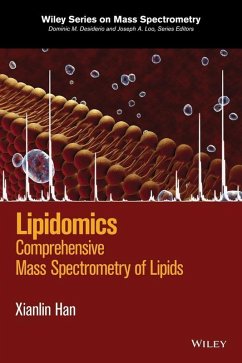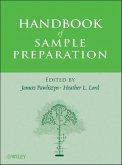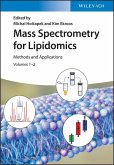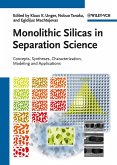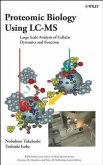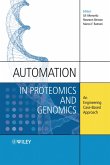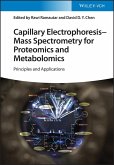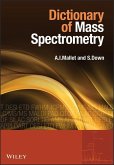134,99 €
134,99 €
inkl. MwSt.
Sofort per Download lieferbar

0 °P sammeln
134,99 €
Als Download kaufen

134,99 €
inkl. MwSt.
Sofort per Download lieferbar

0 °P sammeln
Jetzt verschenken
Alle Infos zum eBook verschenken
134,99 €
inkl. MwSt.
Sofort per Download lieferbar
Alle Infos zum eBook verschenken

0 °P sammeln
- Format: PDF
- Merkliste
- Auf die Merkliste
- Bewerten Bewerten
- Teilen
- Produkt teilen
- Produkterinnerung
- Produkterinnerung

Bitte loggen Sie sich zunächst in Ihr Kundenkonto ein oder registrieren Sie sich bei
bücher.de, um das eBook-Abo tolino select nutzen zu können.
Hier können Sie sich einloggen
Hier können Sie sich einloggen
Sie sind bereits eingeloggt. Klicken Sie auf 2. tolino select Abo, um fortzufahren.

Bitte loggen Sie sich zunächst in Ihr Kundenkonto ein oder registrieren Sie sich bei bücher.de, um das eBook-Abo tolino select nutzen zu können.
Covers the area of lipidomics from fundamentals and theory to applications
Presents a balanced discussion of the fundamentals, theory, experimental methods and applications of lipidomics | Covers different characterizations of lipids including Glycerophospholipids; Sphingolipids; Glycerolipids and Glycolipids; and Fatty Acids and Modified Fatty Acids | Includes a section on quantification of Lipids in Lipidomics such as sample preparation; factors affecting accurate quantification; and data processing and interpretation | Details applications of Lipidomics Tools including for Health and…mehr
- Geräte: PC
- ohne Kopierschutz
- eBook Hilfe
Andere Kunden interessierten sich auch für
![Handbook of Sample Preparation (eBook, PDF) Handbook of Sample Preparation (eBook, PDF)]() Handbook of Sample Preparation (eBook, PDF)162,99 €
Handbook of Sample Preparation (eBook, PDF)162,99 €![Mass Spectrometry for Lipidomics (eBook, PDF) Mass Spectrometry for Lipidomics (eBook, PDF)]() Mass Spectrometry for Lipidomics (eBook, PDF)232,99 €
Mass Spectrometry for Lipidomics (eBook, PDF)232,99 €![Monolithic Silicas in Separation Science (eBook, PDF) Monolithic Silicas in Separation Science (eBook, PDF)]() Monolithic Silicas in Separation Science (eBook, PDF)129,99 €
Monolithic Silicas in Separation Science (eBook, PDF)129,99 €![Proteomic Biology Using LC/MS (eBook, PDF) Proteomic Biology Using LC/MS (eBook, PDF)]() Nobuhiro TakahashiProteomic Biology Using LC/MS (eBook, PDF)101,99 €
Nobuhiro TakahashiProteomic Biology Using LC/MS (eBook, PDF)101,99 €![Automation in Proteomics and Genomics (eBook, PDF) Automation in Proteomics and Genomics (eBook, PDF)]() Gil AlterovitzAutomation in Proteomics and Genomics (eBook, PDF)125,99 €
Gil AlterovitzAutomation in Proteomics and Genomics (eBook, PDF)125,99 €![Capillary Electrophoresis - Mass Spectrometry for Proteomics and Metabolomics (eBook, PDF) Capillary Electrophoresis - Mass Spectrometry for Proteomics and Metabolomics (eBook, PDF)]() Capillary Electrophoresis - Mass Spectrometry for Proteomics and Metabolomics (eBook, PDF)115,99 €
Capillary Electrophoresis - Mass Spectrometry for Proteomics and Metabolomics (eBook, PDF)115,99 €![Dictionary of Mass Spectrometry (eBook, PDF) Dictionary of Mass Spectrometry (eBook, PDF)]() Anthony MalletDictionary of Mass Spectrometry (eBook, PDF)45,99 €
Anthony MalletDictionary of Mass Spectrometry (eBook, PDF)45,99 €-
-
-
Covers the area of lipidomics from fundamentals and theory to applications
- Presents a balanced discussion of the fundamentals, theory, experimental methods and applications of lipidomics
- Covers different characterizations of lipids including Glycerophospholipids; Sphingolipids; Glycerolipids and Glycolipids; and Fatty Acids and Modified Fatty Acids
- Includes a section on quantification of Lipids in Lipidomics such as sample preparation; factors affecting accurate quantification; and data processing and interpretation
- Details applications of Lipidomics Tools including for Health and Disease; Plant Lipidomics; and Lipidomics on Cellular Membranes
Dieser Download kann aus rechtlichen Gründen nur mit Rechnungsadresse in D ausgeliefert werden.
Produktdetails
- Produktdetails
- Verlag: For Dummies
- Erscheinungstermin: 29. März 2016
- Englisch
- ISBN-13: 9781119085287
- Artikelnr.: 44872802
- Verlag: For Dummies
- Erscheinungstermin: 29. März 2016
- Englisch
- ISBN-13: 9781119085287
- Artikelnr.: 44872802
- Herstellerkennzeichnung Die Herstellerinformationen sind derzeit nicht verfügbar.
Xianlin Han is a Professor in the Programs of Cardiovascular Metabolism and Integrative Metabolism at the Sanford Burnham Prebys Medical Discovery Institute. Prof. Han is one of the pioneers in lipidomics and the inventor of shotgun lipidomics. He has published over 180 peer-reviewed papers in journals and 16 invited book chapters with an H-index of 62. He holds 5 international patents. He is the associate editor of "Lipids". Prof. Han serves as a member of the Editorial Board of numerous international journals including J. Lipid Res., Mol. Cell Biol. Lipids in Biochim. Biophys. Acta, Chem. Phys. Lipids, and Anal. Biochem.
FOREWORD xix
PREFACE xxi
ABBREVIATIONS xxv
PART I INTRODUCTION 1
1 Lipids and Lipidomics 3
1.1 Lipids, 3
1.1.1 Definition, 3
1.1.2 Classification, 4
1.1.2.1 Lipid MAPS Approach, 7
1.1.2.2 Building Block Approach, 10
1.2 Lipidomics, 13
1.2.1 Definition, 13
1.2.2 History of Lipidomics, 14
References, 16
2 Mass Spectrometry for Lipidomics 21
2.1 Ionization Techniques, 21
2.1.1 Electrospray Ionization, 22
2.1.1.1 Principle of Electrospray Ionization, 22
2.1.1.2 Features of Electrospray Ionization for Lipid Analysis, 28
2.1.1.3 Advent of ESI for Lipid Analysis: Nano-ESI and Off-Axis Ion Inlets, 30
2.1.2 Matrix-Assisted Laser Desorption/Ionization, 30
2.2 Mass Analyzers, 32
2.2.1 Quadrupole, 32
2.2.2 Time of Flight, 33
2.2.3 Ion Trap, 35
2.3 Detector, 36
2.4 Tandem Mass Spectrometry Techniques, 37
2.4.1 Product-Ion Analysis, 37
2.4.2 Neutral-Loss Scan, 39
2.4.3 Precursor-Ion Scan, 39
2.4.4 Selected Reaction Monitoring, 39
2.4.5 Interweaving Tandem Mass Spectrometry Techniques, 40
2.5 Other Recent Advances in Mass Spectrometry for Lipid Analysis, 42
2.5.1 Ion-Mobility Mass Spectrometry, 43
2.5.2 Desorption Electrospray Ionization, 43
References, 45
3 Mass Spectrometry-Based Lipidomics Approaches 53
3.1 Introduction, 53
3.2 Shotgun Lipidomics: Direct Infusion-Based Approaches, 54
3.2.1 Devices for Direct Infusion, 54
3.2.2 Features of Shotgun Lipidomics, 55
3.2.3 Shotgun Lipidomics Approaches, 56
3.2.3.1 Tandem Mass Spectrometry-Based Shotgun Lipidomics, 56
3.2.3.2 High Mass Accuracy-Based Shotgun Lipidomics, 56
3.2.3.3 Multidimensional MS-Based Shotgun Lipidomics, 57
3.2.4 Advantages and Drawbacks, 63
3.2.4.1 Tandem Mass Spectrometry-Based Shotgun Lipidomics, 63
3.2.4.2 High Mass Accuracy-Based Shotgun Lipidomics, 63
3.2.4.3 Multidimensional Mass Spectrometry-Based Shotgun Lipidomics, 64
3.3 LC-MS-Based Approaches, 65
3.3.1 General, 65
3.3.1.1 Selected Ion Monitoring for LC-MS, 66
3.3.1.2 Selected/Multiple Reaction Monitoring for LC-MS, 67
3.3.1.3 Data-Dependent Analysis after LC-MS, 67
3.3.2 LC-MS-Based Approaches for Lipidomics, 68
3.3.2.1 Normal-Phase LC-MS-Based Approaches, 68
3.3.2.2 Reversed-Phase LC-MS-Based Approaches, 69
3.3.2.3 Hydrophilic Interaction LC-MS-Based Approaches, 71
3.3.2.4 Other LC-MS-Based Approaches, 72
3.3.3 Advantages and Drawbacks, 72
3.3.4 Identification of Lipid Species after LC-MS, 73
3.4 MALDI-MS for Lipidomics, 74
3.4.1 General, 74
3.4.2 Analysis of Lipid Extracts, 74
3.4.3 Advantages and Drawbacks, 75
3.4.4 Recent Advances in MALDI-MS for Lipidomics, 76
3.4.4.1 Utilization of Novel Matrices, 76
3.4.4.2 (HP)TLC-MALDI-MS, 78
3.4.4.3 Matrix-Free Laser Desorption/Ionization
Approaches, 78
References, 79
4 Variables in Mass Spectrometry for Lipidomics 89
4.1 Introduction, 89
4.2 Variables in Lipid Extraction (i.e., Multiplex Extraction Conditions), 89
4.2.1 The pH Conditions of Lipid Extraction, 89
4.2.2 Solvent Polarity of Lipid Extraction, 90
4.2.3 Intrinsic Chemical Properties of Lipids, 90
4.3 Variables in the Infusion Solution, 91
4.3.1 Polarity, Composition, Ion Pairing, and Other Variations in the Infusion Solution, 91
4.3.2 Variations of the Levels or Composition of a Modifier in the Infusion Solution, 93
4.3.3 Lipid Concentration in the Infusion Solution, 97
4.4 Variables in Ionization, 98
4.4.1 Source Temperature, 98
4.4.2 Spray Voltage, 99
4.4.3 Injection/Eluent Flow Rate, 100
4.5 Variables in Building-Block monitoring with MS/MS Scanning, 102
4.5.1 Precursor-Ion Scanning of a Fragment Ion Whose m/z Serves as a Variable, 102
4.5.2 Neutral-Loss Scanning of a Neutral Fragment Whose Mass Serves as a Variable, 102
4.5.3 Fragments Associated with the Building Blocks are the Variables in Product-Ion MS
PREFACE xxi
ABBREVIATIONS xxv
PART I INTRODUCTION 1
1 Lipids and Lipidomics 3
1.1 Lipids, 3
1.1.1 Definition, 3
1.1.2 Classification, 4
1.1.2.1 Lipid MAPS Approach, 7
1.1.2.2 Building Block Approach, 10
1.2 Lipidomics, 13
1.2.1 Definition, 13
1.2.2 History of Lipidomics, 14
References, 16
2 Mass Spectrometry for Lipidomics 21
2.1 Ionization Techniques, 21
2.1.1 Electrospray Ionization, 22
2.1.1.1 Principle of Electrospray Ionization, 22
2.1.1.2 Features of Electrospray Ionization for Lipid Analysis, 28
2.1.1.3 Advent of ESI for Lipid Analysis: Nano-ESI and Off-Axis Ion Inlets, 30
2.1.2 Matrix-Assisted Laser Desorption/Ionization, 30
2.2 Mass Analyzers, 32
2.2.1 Quadrupole, 32
2.2.2 Time of Flight, 33
2.2.3 Ion Trap, 35
2.3 Detector, 36
2.4 Tandem Mass Spectrometry Techniques, 37
2.4.1 Product-Ion Analysis, 37
2.4.2 Neutral-Loss Scan, 39
2.4.3 Precursor-Ion Scan, 39
2.4.4 Selected Reaction Monitoring, 39
2.4.5 Interweaving Tandem Mass Spectrometry Techniques, 40
2.5 Other Recent Advances in Mass Spectrometry for Lipid Analysis, 42
2.5.1 Ion-Mobility Mass Spectrometry, 43
2.5.2 Desorption Electrospray Ionization, 43
References, 45
3 Mass Spectrometry-Based Lipidomics Approaches 53
3.1 Introduction, 53
3.2 Shotgun Lipidomics: Direct Infusion-Based Approaches, 54
3.2.1 Devices for Direct Infusion, 54
3.2.2 Features of Shotgun Lipidomics, 55
3.2.3 Shotgun Lipidomics Approaches, 56
3.2.3.1 Tandem Mass Spectrometry-Based Shotgun Lipidomics, 56
3.2.3.2 High Mass Accuracy-Based Shotgun Lipidomics, 56
3.2.3.3 Multidimensional MS-Based Shotgun Lipidomics, 57
3.2.4 Advantages and Drawbacks, 63
3.2.4.1 Tandem Mass Spectrometry-Based Shotgun Lipidomics, 63
3.2.4.2 High Mass Accuracy-Based Shotgun Lipidomics, 63
3.2.4.3 Multidimensional Mass Spectrometry-Based Shotgun Lipidomics, 64
3.3 LC-MS-Based Approaches, 65
3.3.1 General, 65
3.3.1.1 Selected Ion Monitoring for LC-MS, 66
3.3.1.2 Selected/Multiple Reaction Monitoring for LC-MS, 67
3.3.1.3 Data-Dependent Analysis after LC-MS, 67
3.3.2 LC-MS-Based Approaches for Lipidomics, 68
3.3.2.1 Normal-Phase LC-MS-Based Approaches, 68
3.3.2.2 Reversed-Phase LC-MS-Based Approaches, 69
3.3.2.3 Hydrophilic Interaction LC-MS-Based Approaches, 71
3.3.2.4 Other LC-MS-Based Approaches, 72
3.3.3 Advantages and Drawbacks, 72
3.3.4 Identification of Lipid Species after LC-MS, 73
3.4 MALDI-MS for Lipidomics, 74
3.4.1 General, 74
3.4.2 Analysis of Lipid Extracts, 74
3.4.3 Advantages and Drawbacks, 75
3.4.4 Recent Advances in MALDI-MS for Lipidomics, 76
3.4.4.1 Utilization of Novel Matrices, 76
3.4.4.2 (HP)TLC-MALDI-MS, 78
3.4.4.3 Matrix-Free Laser Desorption/Ionization
Approaches, 78
References, 79
4 Variables in Mass Spectrometry for Lipidomics 89
4.1 Introduction, 89
4.2 Variables in Lipid Extraction (i.e., Multiplex Extraction Conditions), 89
4.2.1 The pH Conditions of Lipid Extraction, 89
4.2.2 Solvent Polarity of Lipid Extraction, 90
4.2.3 Intrinsic Chemical Properties of Lipids, 90
4.3 Variables in the Infusion Solution, 91
4.3.1 Polarity, Composition, Ion Pairing, and Other Variations in the Infusion Solution, 91
4.3.2 Variations of the Levels or Composition of a Modifier in the Infusion Solution, 93
4.3.3 Lipid Concentration in the Infusion Solution, 97
4.4 Variables in Ionization, 98
4.4.1 Source Temperature, 98
4.4.2 Spray Voltage, 99
4.4.3 Injection/Eluent Flow Rate, 100
4.5 Variables in Building-Block monitoring with MS/MS Scanning, 102
4.5.1 Precursor-Ion Scanning of a Fragment Ion Whose m/z Serves as a Variable, 102
4.5.2 Neutral-Loss Scanning of a Neutral Fragment Whose Mass Serves as a Variable, 102
4.5.3 Fragments Associated with the Building Blocks are the Variables in Product-Ion MS
FOREWORD xix
PREFACE xxi
ABBREVIATIONS xxv
PART I INTRODUCTION 1
1 Lipids and Lipidomics 3
1.1 Lipids, 3
1.1.1 Definition, 3
1.1.2 Classification, 4
1.1.2.1 Lipid MAPS Approach, 7
1.1.2.2 Building Block Approach, 10
1.2 Lipidomics, 13
1.2.1 Definition, 13
1.2.2 History of Lipidomics, 14
References, 16
2 Mass Spectrometry for Lipidomics 21
2.1 Ionization Techniques, 21
2.1.1 Electrospray Ionization, 22
2.1.1.1 Principle of Electrospray Ionization, 22
2.1.1.2 Features of Electrospray Ionization for Lipid Analysis, 28
2.1.1.3 Advent of ESI for Lipid Analysis: Nano-ESI and Off-Axis Ion Inlets, 30
2.1.2 Matrix-Assisted Laser Desorption/Ionization, 30
2.2 Mass Analyzers, 32
2.2.1 Quadrupole, 32
2.2.2 Time of Flight, 33
2.2.3 Ion Trap, 35
2.3 Detector, 36
2.4 Tandem Mass Spectrometry Techniques, 37
2.4.1 Product-Ion Analysis, 37
2.4.2 Neutral-Loss Scan, 39
2.4.3 Precursor-Ion Scan, 39
2.4.4 Selected Reaction Monitoring, 39
2.4.5 Interweaving Tandem Mass Spectrometry Techniques, 40
2.5 Other Recent Advances in Mass Spectrometry for Lipid Analysis, 42
2.5.1 Ion-Mobility Mass Spectrometry, 43
2.5.2 Desorption Electrospray Ionization, 43
References, 45
3 Mass Spectrometry-Based Lipidomics Approaches 53
3.1 Introduction, 53
3.2 Shotgun Lipidomics: Direct Infusion-Based Approaches, 54
3.2.1 Devices for Direct Infusion, 54
3.2.2 Features of Shotgun Lipidomics, 55
3.2.3 Shotgun Lipidomics Approaches, 56
3.2.3.1 Tandem Mass Spectrometry-Based Shotgun Lipidomics, 56
3.2.3.2 High Mass Accuracy-Based Shotgun Lipidomics, 56
3.2.3.3 Multidimensional MS-Based Shotgun Lipidomics, 57
3.2.4 Advantages and Drawbacks, 63
3.2.4.1 Tandem Mass Spectrometry-Based Shotgun Lipidomics, 63
3.2.4.2 High Mass Accuracy-Based Shotgun Lipidomics, 63
3.2.4.3 Multidimensional Mass Spectrometry-Based Shotgun Lipidomics, 64
3.3 LC-MS-Based Approaches, 65
3.3.1 General, 65
3.3.1.1 Selected Ion Monitoring for LC-MS, 66
3.3.1.2 Selected/Multiple Reaction Monitoring for LC-MS, 67
3.3.1.3 Data-Dependent Analysis after LC-MS, 67
3.3.2 LC-MS-Based Approaches for Lipidomics, 68
3.3.2.1 Normal-Phase LC-MS-Based Approaches, 68
3.3.2.2 Reversed-Phase LC-MS-Based Approaches, 69
3.3.2.3 Hydrophilic Interaction LC-MS-Based Approaches, 71
3.3.2.4 Other LC-MS-Based Approaches, 72
3.3.3 Advantages and Drawbacks, 72
3.3.4 Identification of Lipid Species after LC-MS, 73
3.4 MALDI-MS for Lipidomics, 74
3.4.1 General, 74
3.4.2 Analysis of Lipid Extracts, 74
3.4.3 Advantages and Drawbacks, 75
3.4.4 Recent Advances in MALDI-MS for Lipidomics, 76
3.4.4.1 Utilization of Novel Matrices, 76
3.4.4.2 (HP)TLC-MALDI-MS, 78
3.4.4.3 Matrix-Free Laser Desorption/Ionization
Approaches, 78
References, 79
4 Variables in Mass Spectrometry for Lipidomics 89
4.1 Introduction, 89
4.2 Variables in Lipid Extraction (i.e., Multiplex Extraction Conditions), 89
4.2.1 The pH Conditions of Lipid Extraction, 89
4.2.2 Solvent Polarity of Lipid Extraction, 90
4.2.3 Intrinsic Chemical Properties of Lipids, 90
4.3 Variables in the Infusion Solution, 91
4.3.1 Polarity, Composition, Ion Pairing, and Other Variations in the Infusion Solution, 91
4.3.2 Variations of the Levels or Composition of a Modifier in the Infusion Solution, 93
4.3.3 Lipid Concentration in the Infusion Solution, 97
4.4 Variables in Ionization, 98
4.4.1 Source Temperature, 98
4.4.2 Spray Voltage, 99
4.4.3 Injection/Eluent Flow Rate, 100
4.5 Variables in Building-Block monitoring with MS/MS Scanning, 102
4.5.1 Precursor-Ion Scanning of a Fragment Ion Whose m/z Serves as a Variable, 102
4.5.2 Neutral-Loss Scanning of a Neutral Fragment Whose Mass Serves as a Variable, 102
4.5.3 Fragments Associated with the Building Blocks are the Variables in Product-Ion MS
PREFACE xxi
ABBREVIATIONS xxv
PART I INTRODUCTION 1
1 Lipids and Lipidomics 3
1.1 Lipids, 3
1.1.1 Definition, 3
1.1.2 Classification, 4
1.1.2.1 Lipid MAPS Approach, 7
1.1.2.2 Building Block Approach, 10
1.2 Lipidomics, 13
1.2.1 Definition, 13
1.2.2 History of Lipidomics, 14
References, 16
2 Mass Spectrometry for Lipidomics 21
2.1 Ionization Techniques, 21
2.1.1 Electrospray Ionization, 22
2.1.1.1 Principle of Electrospray Ionization, 22
2.1.1.2 Features of Electrospray Ionization for Lipid Analysis, 28
2.1.1.3 Advent of ESI for Lipid Analysis: Nano-ESI and Off-Axis Ion Inlets, 30
2.1.2 Matrix-Assisted Laser Desorption/Ionization, 30
2.2 Mass Analyzers, 32
2.2.1 Quadrupole, 32
2.2.2 Time of Flight, 33
2.2.3 Ion Trap, 35
2.3 Detector, 36
2.4 Tandem Mass Spectrometry Techniques, 37
2.4.1 Product-Ion Analysis, 37
2.4.2 Neutral-Loss Scan, 39
2.4.3 Precursor-Ion Scan, 39
2.4.4 Selected Reaction Monitoring, 39
2.4.5 Interweaving Tandem Mass Spectrometry Techniques, 40
2.5 Other Recent Advances in Mass Spectrometry for Lipid Analysis, 42
2.5.1 Ion-Mobility Mass Spectrometry, 43
2.5.2 Desorption Electrospray Ionization, 43
References, 45
3 Mass Spectrometry-Based Lipidomics Approaches 53
3.1 Introduction, 53
3.2 Shotgun Lipidomics: Direct Infusion-Based Approaches, 54
3.2.1 Devices for Direct Infusion, 54
3.2.2 Features of Shotgun Lipidomics, 55
3.2.3 Shotgun Lipidomics Approaches, 56
3.2.3.1 Tandem Mass Spectrometry-Based Shotgun Lipidomics, 56
3.2.3.2 High Mass Accuracy-Based Shotgun Lipidomics, 56
3.2.3.3 Multidimensional MS-Based Shotgun Lipidomics, 57
3.2.4 Advantages and Drawbacks, 63
3.2.4.1 Tandem Mass Spectrometry-Based Shotgun Lipidomics, 63
3.2.4.2 High Mass Accuracy-Based Shotgun Lipidomics, 63
3.2.4.3 Multidimensional Mass Spectrometry-Based Shotgun Lipidomics, 64
3.3 LC-MS-Based Approaches, 65
3.3.1 General, 65
3.3.1.1 Selected Ion Monitoring for LC-MS, 66
3.3.1.2 Selected/Multiple Reaction Monitoring for LC-MS, 67
3.3.1.3 Data-Dependent Analysis after LC-MS, 67
3.3.2 LC-MS-Based Approaches for Lipidomics, 68
3.3.2.1 Normal-Phase LC-MS-Based Approaches, 68
3.3.2.2 Reversed-Phase LC-MS-Based Approaches, 69
3.3.2.3 Hydrophilic Interaction LC-MS-Based Approaches, 71
3.3.2.4 Other LC-MS-Based Approaches, 72
3.3.3 Advantages and Drawbacks, 72
3.3.4 Identification of Lipid Species after LC-MS, 73
3.4 MALDI-MS for Lipidomics, 74
3.4.1 General, 74
3.4.2 Analysis of Lipid Extracts, 74
3.4.3 Advantages and Drawbacks, 75
3.4.4 Recent Advances in MALDI-MS for Lipidomics, 76
3.4.4.1 Utilization of Novel Matrices, 76
3.4.4.2 (HP)TLC-MALDI-MS, 78
3.4.4.3 Matrix-Free Laser Desorption/Ionization
Approaches, 78
References, 79
4 Variables in Mass Spectrometry for Lipidomics 89
4.1 Introduction, 89
4.2 Variables in Lipid Extraction (i.e., Multiplex Extraction Conditions), 89
4.2.1 The pH Conditions of Lipid Extraction, 89
4.2.2 Solvent Polarity of Lipid Extraction, 90
4.2.3 Intrinsic Chemical Properties of Lipids, 90
4.3 Variables in the Infusion Solution, 91
4.3.1 Polarity, Composition, Ion Pairing, and Other Variations in the Infusion Solution, 91
4.3.2 Variations of the Levels or Composition of a Modifier in the Infusion Solution, 93
4.3.3 Lipid Concentration in the Infusion Solution, 97
4.4 Variables in Ionization, 98
4.4.1 Source Temperature, 98
4.4.2 Spray Voltage, 99
4.4.3 Injection/Eluent Flow Rate, 100
4.5 Variables in Building-Block monitoring with MS/MS Scanning, 102
4.5.1 Precursor-Ion Scanning of a Fragment Ion Whose m/z Serves as a Variable, 102
4.5.2 Neutral-Loss Scanning of a Neutral Fragment Whose Mass Serves as a Variable, 102
4.5.3 Fragments Associated with the Building Blocks are the Variables in Product-Ion MS
